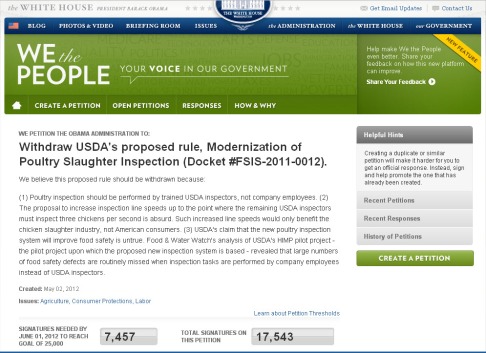A coalition of 23 groups and 16 individuals today urged the Department of Agriculture to withdraw a proposal that increases poultry processing line speeds and removes hundreds of federal inspectors from poultry processing plants.
The proposal, which would modify USDA’s poultry slaughter inspection program, increases the poultry line speed to an unsafe level and allows plant employees to replace federal government inspectors for certain inspection activities. In addition, the proposal reduces the numbers of federal inspectors working at poultry plants. While the poultry inspection program does need improving, the proposal was developed with limited public input. USDA did not consult with its inspection advisory committee prior to issuing its proposal; nor were public meetings held to solicit the views of the public before the proposal was announced. In addition, the groups highlighted a number of critical food safety and worker safety concerns raised by the proposal.
Specifically, the coalition is alarmed by the proposed increase in poultry slaughter line speeds to 175 birds per minute, a five-fold increase over current speeds. At such rates, government inspectors would have only one-third of a second to examine each chicken carcass for food safety risks and other problems. Further, increased line speeds would contribute to higher rates of carpal tunnel syndrome and other repetitive motion injuries among poultry plant workers.
The coalition is also concerned that the proposal would change the standards for accepting or rejecting birds. There is no provision in the new rule mandating training of plant employees, who would be assigned tasks previously conducted by federal government inspectors. USDA whistleblowers have commented that plant workers with insufficient training often overlook things. Moreover,employers might pressure plant employees to let as many birds pass as possible. As a result, there would likely be an increase in the rate of “defects” such as bruises, scabs, bile and ingesta on the carcasses.
Finally, the coalition is concerned that the proposal does not require a standard for testing of poultry. Instead, the proposal would allow each plant to develop its own testing protocol. Plants would also not be required to test for Salmonella or Campylobacter, the two foodborne pathogens most often associated with raw poultry.
According to data from the Centers for Disease Control and Prevention, there has been no significant progress since 1999 in reducing illnesses from Salmonella and Campylobacter. Salmonella is the leading cause of death and hospitalization due to a known foodborne pathogen. A 2011 report from the University of Florida found that Campylobacter in poultry led the list of pathogen/food combinations that account for 60% of all foodborne illnesses.
The coalition is urging the Department of Agriculture to withdraw the proposal until these issues and others can be adequately addressed.
The letter was signed by the following groups and individuals:
AFL-CIO; American Federation of Government Employees, AFL-CIO; CATA, El Comite de Apoyo a los Trabajadores Agricolas; Center for Food Safety; Center for Foodborne Illness Research & Prevention; Centro de los Derechos del Migrante, Inc.; Consumer Federation of America; Center for Science in the Public Interest; Food & Water Watch; Government Accountability Project; Midwest Coalition for Human Rights; National Consumers League; National Council of La Raza (NCLR); National Council for Occupational Safety and Health; National Employment Law Project; Nebraska Appleseed Center for Law in the Public Interest; OMB Watch; Public Citizen; Southern Poverty Law Center; STOP Foodborne Illness; United Support and Memorial for Workplace Fatalities; U.S. PIRG; Worksafe





